Comprehensive Report: Aspects of Contract and Negligence in Business
VerifiedAdded on 2020/02/12
|16
|5796
|67
Report
AI Summary
This report delves into the fundamental aspects of contract and negligence law within a business context. It begins by outlining the essential elements of a valid contract, including offer, acceptance, consideration, competency, and intention to create legal relations, while also exploring the impact of different contract types such as bilateral, unilateral, void, voidable, and distance selling contracts. The report then analyzes various terms within a contract, including express, implied, conditions, warranties, innominate terms, and exclusion clauses. Furthermore, it addresses the concept of tort law, specifically focusing on the tort of negligence, professional negligence, and vicarious liability, providing case scenarios to illustrate the application of these legal principles. The report concludes with a comprehensive overview of the key concepts and their implications in business, including the applicability of legal principles of tort of professional negligence and vicarious liability in the given cases.

By submitting this form and signing below, I declare that:
I am the author of this assignment and that any assistance I received in its preparation is
fully disclosed and acknowledged in this assignment
I also certify that this assignment was prepared by me specifically for this course
I certify that I have taken all reasonable precautions to make sure that my work has not
been copied by other students
I confirm that I have understood the College’s regulations on plagiarism
I confirm that research resources are fully acknowledged
Aspects of Contract and
Negligence for Business
Plagiarism is presenting somebody else’s work as your own. It includes: copying information
directly from the Web or books without referencing the material; submitting joint coursework
as an individual effort; copying another student’s coursework; stealing coursework from
another student and submitting it as your own work. Suspected plagiarism will be investigated
and if found to have occurred will be dealt with according to the procedures set down by the
I am the author of this assignment and that any assistance I received in its preparation is
fully disclosed and acknowledged in this assignment
I also certify that this assignment was prepared by me specifically for this course
I certify that I have taken all reasonable precautions to make sure that my work has not
been copied by other students
I confirm that I have understood the College’s regulations on plagiarism
I confirm that research resources are fully acknowledged
Aspects of Contract and
Negligence for Business
Plagiarism is presenting somebody else’s work as your own. It includes: copying information
directly from the Web or books without referencing the material; submitting joint coursework
as an individual effort; copying another student’s coursework; stealing coursework from
another student and submitting it as your own work. Suspected plagiarism will be investigated
and if found to have occurred will be dealt with according to the procedures set down by the
Paraphrase This Document
Need a fresh take? Get an instant paraphrase of this document with our AI Paraphraser
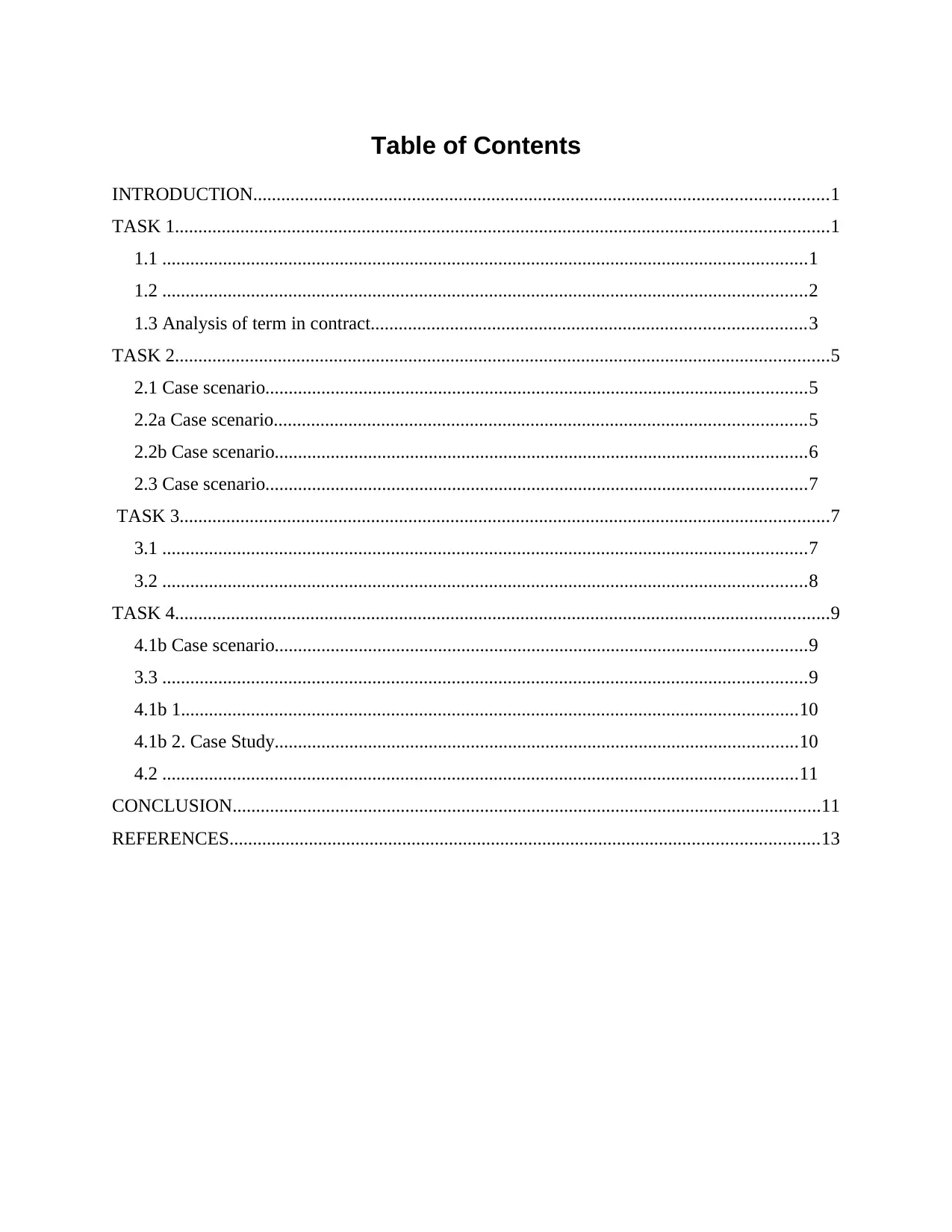
Table of Contents
INTRODUCTION...........................................................................................................................1
TASK 1............................................................................................................................................1
1.1 ..........................................................................................................................................1
1.2 ..........................................................................................................................................2
1.3 Analysis of term in contract.............................................................................................3
TASK 2............................................................................................................................................5
2.1 Case scenario....................................................................................................................5
2.2a Case scenario..................................................................................................................5
2.2b Case scenario..................................................................................................................6
2.3 Case scenario....................................................................................................................7
TASK 3...........................................................................................................................................7
3.1 ..........................................................................................................................................7
3.2 ..........................................................................................................................................8
TASK 4............................................................................................................................................9
4.1b Case scenario..................................................................................................................9
3.3 ..........................................................................................................................................9
4.1b 1....................................................................................................................................10
4.1b 2. Case Study................................................................................................................10
4.2 ........................................................................................................................................11
CONCLUSION..............................................................................................................................11
REFERENCES..............................................................................................................................13
INTRODUCTION...........................................................................................................................1
TASK 1............................................................................................................................................1
1.1 ..........................................................................................................................................1
1.2 ..........................................................................................................................................2
1.3 Analysis of term in contract.............................................................................................3
TASK 2............................................................................................................................................5
2.1 Case scenario....................................................................................................................5
2.2a Case scenario..................................................................................................................5
2.2b Case scenario..................................................................................................................6
2.3 Case scenario....................................................................................................................7
TASK 3...........................................................................................................................................7
3.1 ..........................................................................................................................................7
3.2 ..........................................................................................................................................8
TASK 4............................................................................................................................................9
4.1b Case scenario..................................................................................................................9
3.3 ..........................................................................................................................................9
4.1b 1....................................................................................................................................10
4.1b 2. Case Study................................................................................................................10
4.2 ........................................................................................................................................11
CONCLUSION..............................................................................................................................11
REFERENCES..............................................................................................................................13
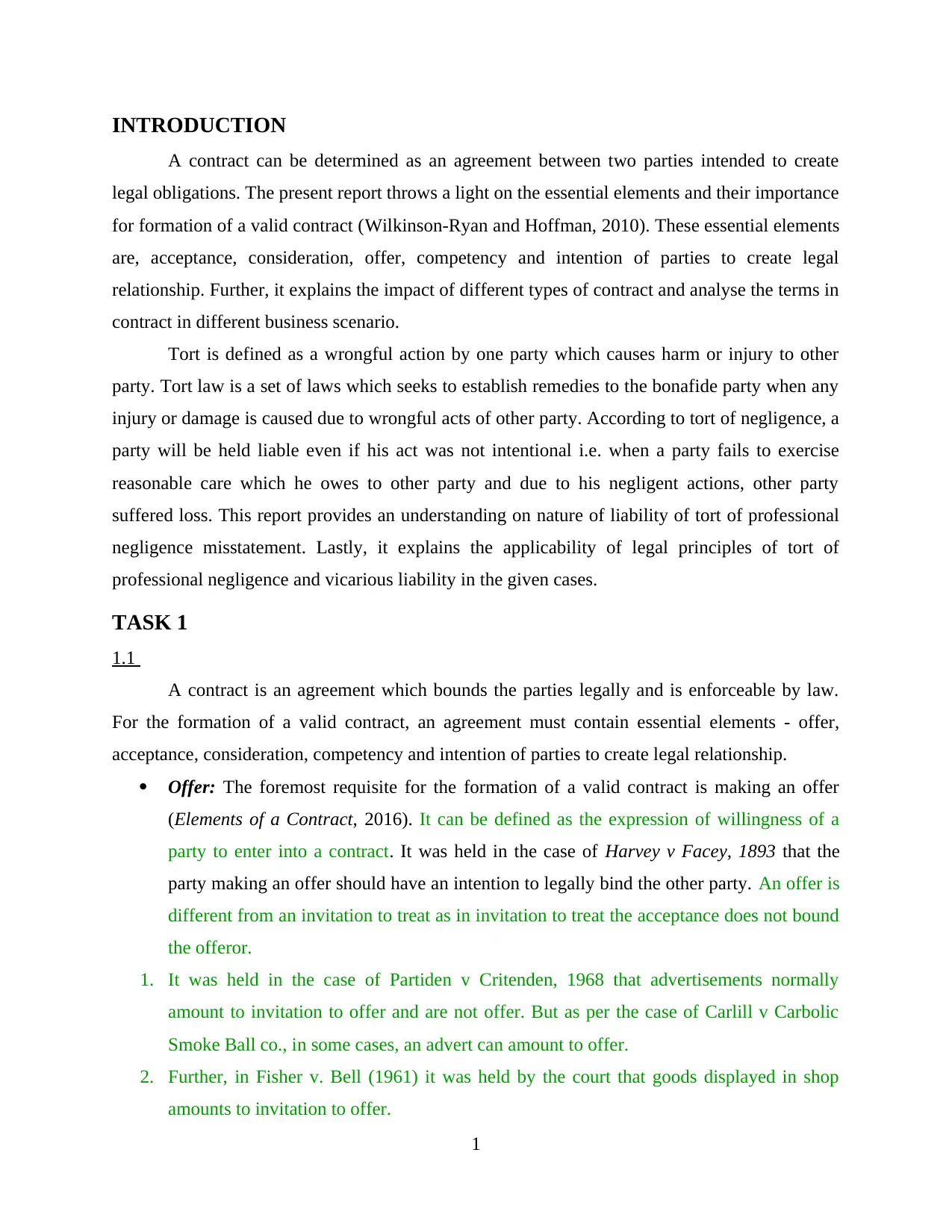
INTRODUCTION
A contract can be determined as an agreement between two parties intended to create
legal obligations. The present report throws a light on the essential elements and their importance
for formation of a valid contract (Wilkinson-Ryan and Hoffman, 2010). These essential elements
are, acceptance, consideration, offer, competency and intention of parties to create legal
relationship. Further, it explains the impact of different types of contract and analyse the terms in
contract in different business scenario.
Tort is defined as a wrongful action by one party which causes harm or injury to other
party. Tort law is a set of laws which seeks to establish remedies to the bonafide party when any
injury or damage is caused due to wrongful acts of other party. According to tort of negligence, a
party will be held liable even if his act was not intentional i.e. when a party fails to exercise
reasonable care which he owes to other party and due to his negligent actions, other party
suffered loss. This report provides an understanding on nature of liability of tort of professional
negligence misstatement. Lastly, it explains the applicability of legal principles of tort of
professional negligence and vicarious liability in the given cases.
TASK 1
1.1
A contract is an agreement which bounds the parties legally and is enforceable by law.
For the formation of a valid contract, an agreement must contain essential elements - offer,
acceptance, consideration, competency and intention of parties to create legal relationship.
Offer: The foremost requisite for the formation of a valid contract is making an offer
(Elements of a Contract, 2016). It can be defined as the expression of willingness of a
party to enter into a contract. It was held in the case of Harvey v Facey, 1893 that the
party making an offer should have an intention to legally bind the other party. An offer is
different from an invitation to treat as in invitation to treat the acceptance does not bound
the offeror.
1. It was held in the case of Partiden v Critenden, 1968 that advertisements normally
amount to invitation to offer and are not offer. But as per the case of Carlill v Carbolic
Smoke Ball co., in some cases, an advert can amount to offer.
2. Further, in Fisher v. Bell (1961) it was held by the court that goods displayed in shop
amounts to invitation to offer.
1
A contract can be determined as an agreement between two parties intended to create
legal obligations. The present report throws a light on the essential elements and their importance
for formation of a valid contract (Wilkinson-Ryan and Hoffman, 2010). These essential elements
are, acceptance, consideration, offer, competency and intention of parties to create legal
relationship. Further, it explains the impact of different types of contract and analyse the terms in
contract in different business scenario.
Tort is defined as a wrongful action by one party which causes harm or injury to other
party. Tort law is a set of laws which seeks to establish remedies to the bonafide party when any
injury or damage is caused due to wrongful acts of other party. According to tort of negligence, a
party will be held liable even if his act was not intentional i.e. when a party fails to exercise
reasonable care which he owes to other party and due to his negligent actions, other party
suffered loss. This report provides an understanding on nature of liability of tort of professional
negligence misstatement. Lastly, it explains the applicability of legal principles of tort of
professional negligence and vicarious liability in the given cases.
TASK 1
1.1
A contract is an agreement which bounds the parties legally and is enforceable by law.
For the formation of a valid contract, an agreement must contain essential elements - offer,
acceptance, consideration, competency and intention of parties to create legal relationship.
Offer: The foremost requisite for the formation of a valid contract is making an offer
(Elements of a Contract, 2016). It can be defined as the expression of willingness of a
party to enter into a contract. It was held in the case of Harvey v Facey, 1893 that the
party making an offer should have an intention to legally bind the other party. An offer is
different from an invitation to treat as in invitation to treat the acceptance does not bound
the offeror.
1. It was held in the case of Partiden v Critenden, 1968 that advertisements normally
amount to invitation to offer and are not offer. But as per the case of Carlill v Carbolic
Smoke Ball co., in some cases, an advert can amount to offer.
2. Further, in Fisher v. Bell (1961) it was held by the court that goods displayed in shop
amounts to invitation to offer.
1
⊘ This is a preview!⊘
Do you want full access?
Subscribe today to unlock all pages.

Trusted by 1+ million students worldwide
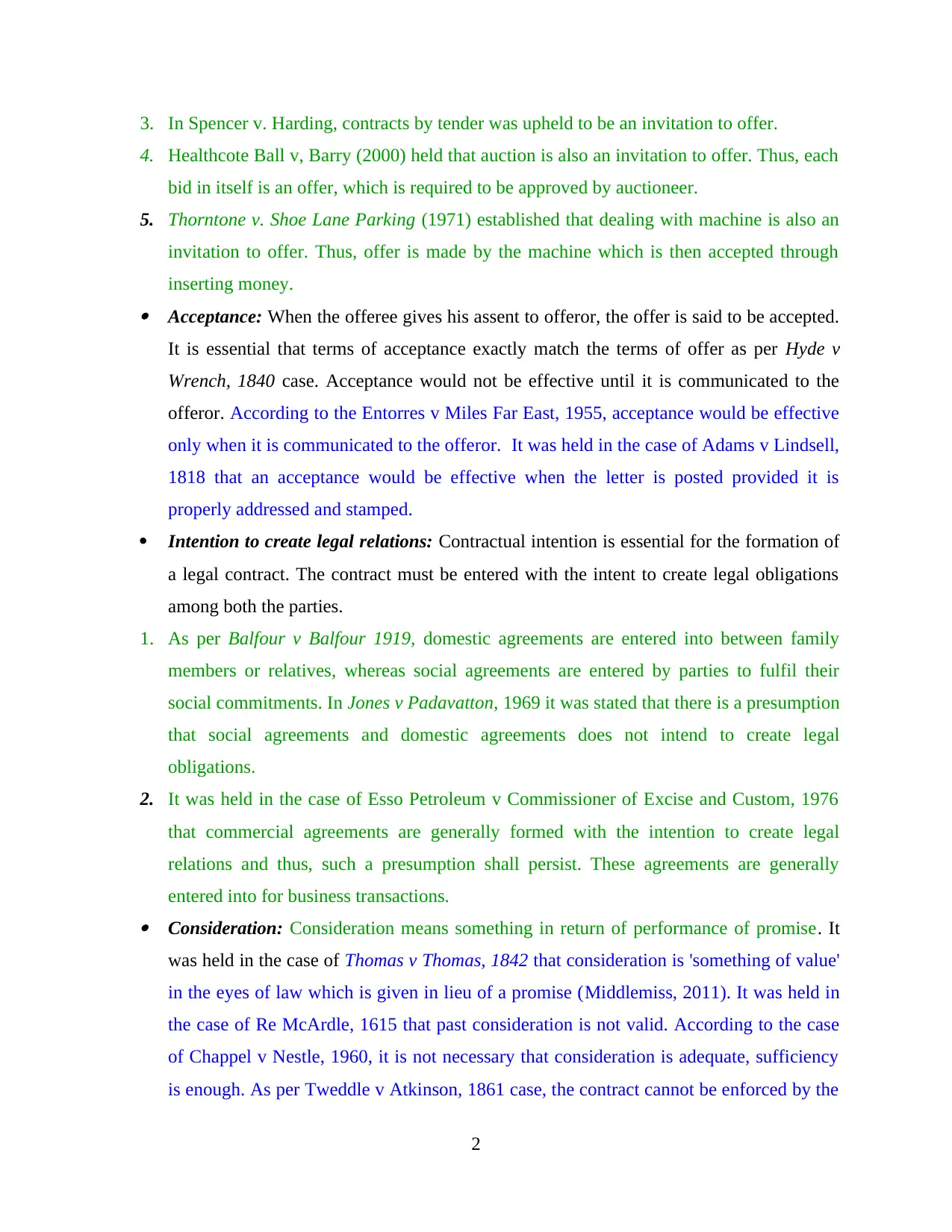
3. In Spencer v. Harding, contracts by tender was upheld to be an invitation to offer.
4. Healthcote Ball v, Barry (2000) held that auction is also an invitation to offer. Thus, each
bid in itself is an offer, which is required to be approved by auctioneer.
5. Thorntone v. Shoe Lane Parking (1971) established that dealing with machine is also an
invitation to offer. Thus, offer is made by the machine which is then accepted through
inserting money. Acceptance: When the offeree gives his assent to offeror, the offer is said to be accepted.
It is essential that terms of acceptance exactly match the terms of offer as per Hyde v
Wrench, 1840 case. Acceptance would not be effective until it is communicated to the
offeror. According to the Entorres v Miles Far East, 1955, acceptance would be effective
only when it is communicated to the offeror. It was held in the case of Adams v Lindsell,
1818 that an acceptance would be effective when the letter is posted provided it is
properly addressed and stamped.
Intention to create legal relations: Contractual intention is essential for the formation of
a legal contract. The contract must be entered with the intent to create legal obligations
among both the parties.
1. As per Balfour v Balfour 1919, domestic agreements are entered into between family
members or relatives, whereas social agreements are entered by parties to fulfil their
social commitments. In Jones v Padavatton, 1969 it was stated that there is a presumption
that social agreements and domestic agreements does not intend to create legal
obligations.
2. It was held in the case of Esso Petroleum v Commissioner of Excise and Custom, 1976
that commercial agreements are generally formed with the intention to create legal
relations and thus, such a presumption shall persist. These agreements are generally
entered into for business transactions. Consideration: Consideration means something in return of performance of promise. It
was held in the case of Thomas v Thomas, 1842 that consideration is 'something of value'
in the eyes of law which is given in lieu of a promise (Middlemiss, 2011). It was held in
the case of Re McArdle, 1615 that past consideration is not valid. According to the case
of Chappel v Nestle, 1960, it is not necessary that consideration is adequate, sufficiency
is enough. As per Tweddle v Atkinson, 1861 case, the contract cannot be enforced by the
2
4. Healthcote Ball v, Barry (2000) held that auction is also an invitation to offer. Thus, each
bid in itself is an offer, which is required to be approved by auctioneer.
5. Thorntone v. Shoe Lane Parking (1971) established that dealing with machine is also an
invitation to offer. Thus, offer is made by the machine which is then accepted through
inserting money. Acceptance: When the offeree gives his assent to offeror, the offer is said to be accepted.
It is essential that terms of acceptance exactly match the terms of offer as per Hyde v
Wrench, 1840 case. Acceptance would not be effective until it is communicated to the
offeror. According to the Entorres v Miles Far East, 1955, acceptance would be effective
only when it is communicated to the offeror. It was held in the case of Adams v Lindsell,
1818 that an acceptance would be effective when the letter is posted provided it is
properly addressed and stamped.
Intention to create legal relations: Contractual intention is essential for the formation of
a legal contract. The contract must be entered with the intent to create legal obligations
among both the parties.
1. As per Balfour v Balfour 1919, domestic agreements are entered into between family
members or relatives, whereas social agreements are entered by parties to fulfil their
social commitments. In Jones v Padavatton, 1969 it was stated that there is a presumption
that social agreements and domestic agreements does not intend to create legal
obligations.
2. It was held in the case of Esso Petroleum v Commissioner of Excise and Custom, 1976
that commercial agreements are generally formed with the intention to create legal
relations and thus, such a presumption shall persist. These agreements are generally
entered into for business transactions. Consideration: Consideration means something in return of performance of promise. It
was held in the case of Thomas v Thomas, 1842 that consideration is 'something of value'
in the eyes of law which is given in lieu of a promise (Middlemiss, 2011). It was held in
the case of Re McArdle, 1615 that past consideration is not valid. According to the case
of Chappel v Nestle, 1960, it is not necessary that consideration is adequate, sufficiency
is enough. As per Tweddle v Atkinson, 1861 case, the contract cannot be enforced by the
2
Paraphrase This Document
Need a fresh take? Get an instant paraphrase of this document with our AI Paraphraser
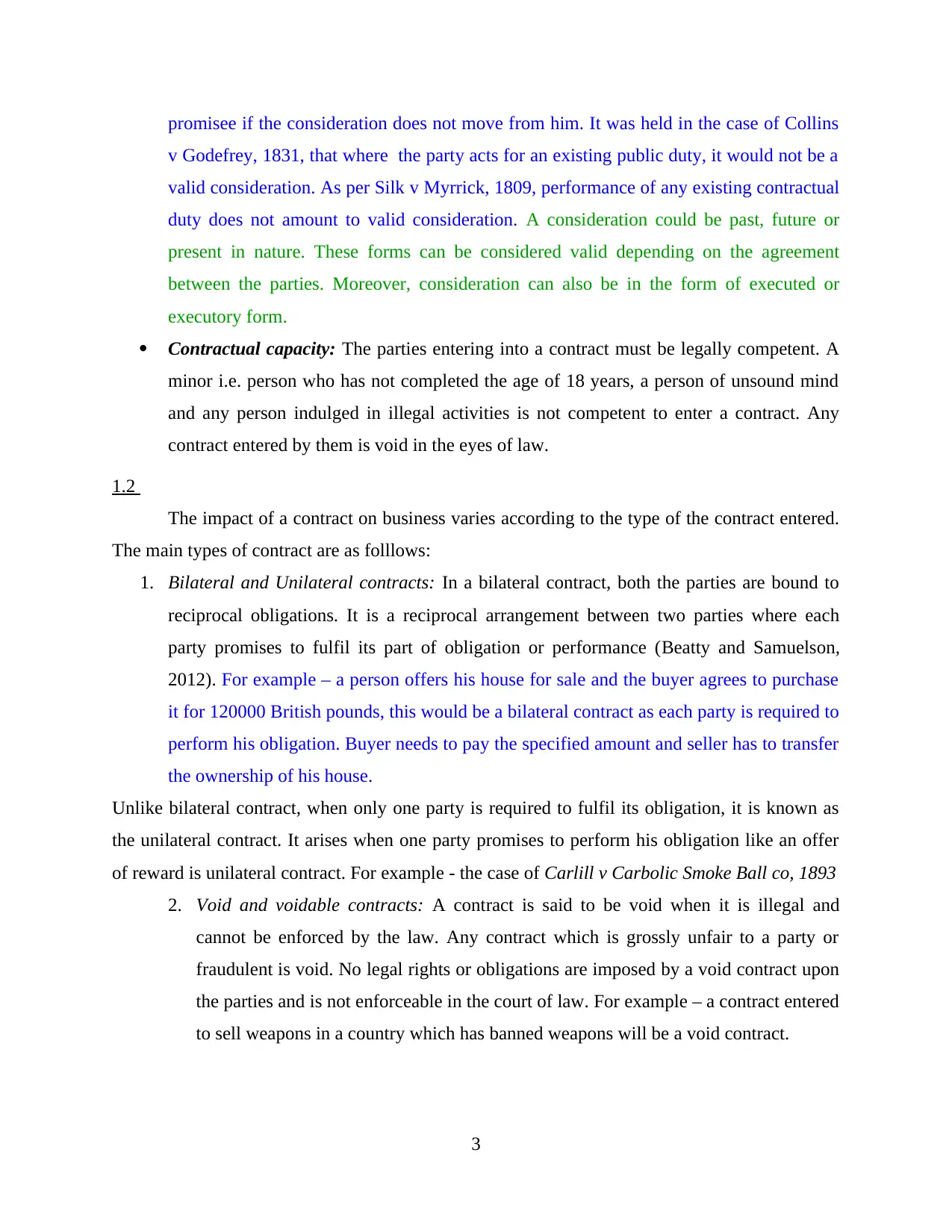
promisee if the consideration does not move from him. It was held in the case of Collins
v Godefrey, 1831, that where the party acts for an existing public duty, it would not be a
valid consideration. As per Silk v Myrrick, 1809, performance of any existing contractual
duty does not amount to valid consideration. A consideration could be past, future or
present in nature. These forms can be considered valid depending on the agreement
between the parties. Moreover, consideration can also be in the form of executed or
executory form.
Contractual capacity: The parties entering into a contract must be legally competent. A
minor i.e. person who has not completed the age of 18 years, a person of unsound mind
and any person indulged in illegal activities is not competent to enter a contract. Any
contract entered by them is void in the eyes of law.
1.2
The impact of a contract on business varies according to the type of the contract entered.
The main types of contract are as folllows:
1. Bilateral and Unilateral contracts: In a bilateral contract, both the parties are bound to
reciprocal obligations. It is a reciprocal arrangement between two parties where each
party promises to fulfil its part of obligation or performance (Beatty and Samuelson,
2012). For example – a person offers his house for sale and the buyer agrees to purchase
it for 120000 British pounds, this would be a bilateral contract as each party is required to
perform his obligation. Buyer needs to pay the specified amount and seller has to transfer
the ownership of his house.
Unlike bilateral contract, when only one party is required to fulfil its obligation, it is known as
the unilateral contract. It arises when one party promises to perform his obligation like an offer
of reward is unilateral contract. For example - the case of Carlill v Carbolic Smoke Ball co, 1893
2. Void and voidable contracts: A contract is said to be void when it is illegal and
cannot be enforced by the law. Any contract which is grossly unfair to a party or
fraudulent is void. No legal rights or obligations are imposed by a void contract upon
the parties and is not enforceable in the court of law. For example – a contract entered
to sell weapons in a country which has banned weapons will be a void contract.
3
v Godefrey, 1831, that where the party acts for an existing public duty, it would not be a
valid consideration. As per Silk v Myrrick, 1809, performance of any existing contractual
duty does not amount to valid consideration. A consideration could be past, future or
present in nature. These forms can be considered valid depending on the agreement
between the parties. Moreover, consideration can also be in the form of executed or
executory form.
Contractual capacity: The parties entering into a contract must be legally competent. A
minor i.e. person who has not completed the age of 18 years, a person of unsound mind
and any person indulged in illegal activities is not competent to enter a contract. Any
contract entered by them is void in the eyes of law.
1.2
The impact of a contract on business varies according to the type of the contract entered.
The main types of contract are as folllows:
1. Bilateral and Unilateral contracts: In a bilateral contract, both the parties are bound to
reciprocal obligations. It is a reciprocal arrangement between two parties where each
party promises to fulfil its part of obligation or performance (Beatty and Samuelson,
2012). For example – a person offers his house for sale and the buyer agrees to purchase
it for 120000 British pounds, this would be a bilateral contract as each party is required to
perform his obligation. Buyer needs to pay the specified amount and seller has to transfer
the ownership of his house.
Unlike bilateral contract, when only one party is required to fulfil its obligation, it is known as
the unilateral contract. It arises when one party promises to perform his obligation like an offer
of reward is unilateral contract. For example - the case of Carlill v Carbolic Smoke Ball co, 1893
2. Void and voidable contracts: A contract is said to be void when it is illegal and
cannot be enforced by the law. Any contract which is grossly unfair to a party or
fraudulent is void. No legal rights or obligations are imposed by a void contract upon
the parties and is not enforceable in the court of law. For example – a contract entered
to sell weapons in a country which has banned weapons will be a void contract.
3
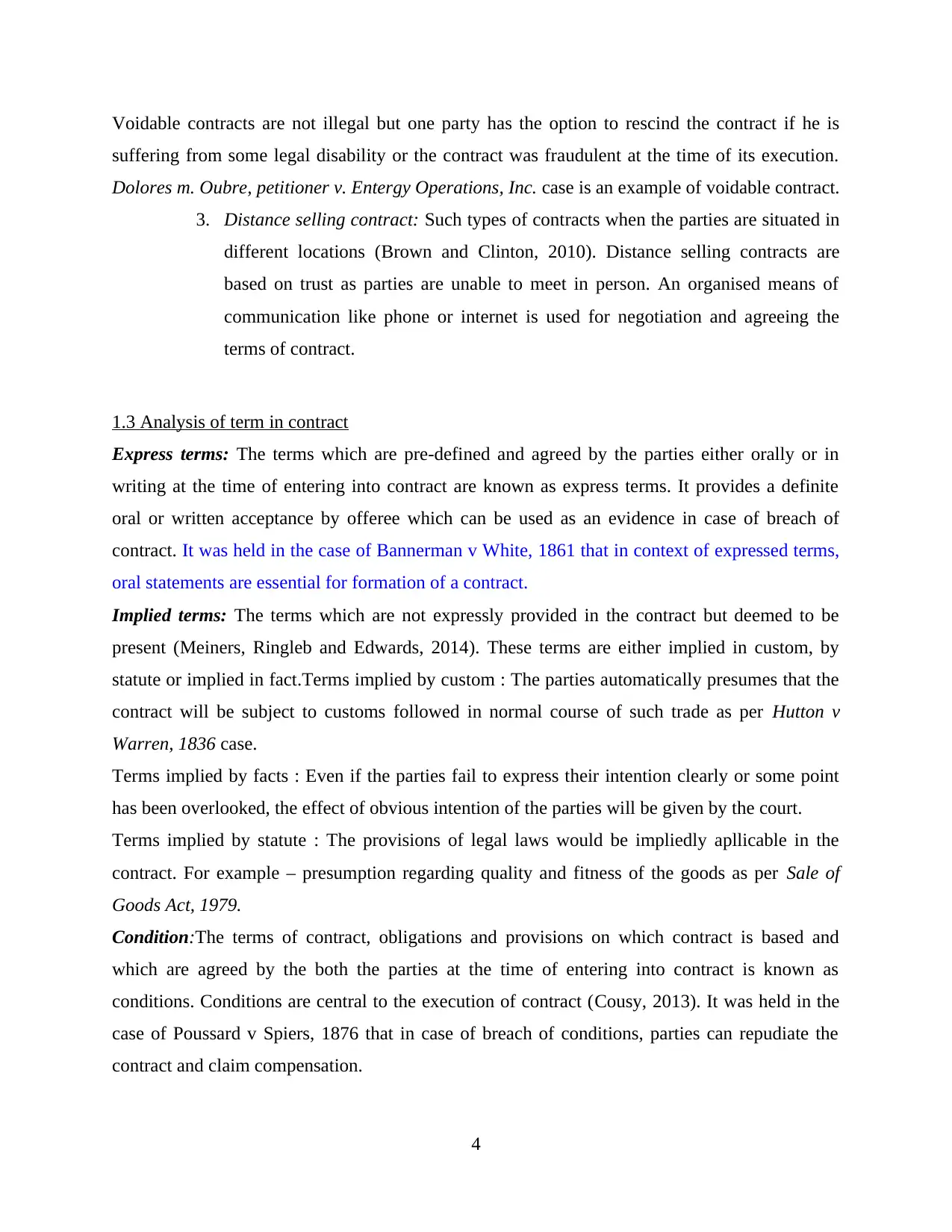
Voidable contracts are not illegal but one party has the option to rescind the contract if he is
suffering from some legal disability or the contract was fraudulent at the time of its execution.
Dolores m. Oubre, petitioner v. Entergy Operations, Inc. case is an example of voidable contract.
3. Distance selling contract: Such types of contracts when the parties are situated in
different locations (Brown and Clinton, 2010). Distance selling contracts are
based on trust as parties are unable to meet in person. An organised means of
communication like phone or internet is used for negotiation and agreeing the
terms of contract.
1.3 Analysis of term in contract
Express terms: The terms which are pre-defined and agreed by the parties either orally or in
writing at the time of entering into contract are known as express terms. It provides a definite
oral or written acceptance by offeree which can be used as an evidence in case of breach of
contract. It was held in the case of Bannerman v White, 1861 that in context of expressed terms,
oral statements are essential for formation of a contract.
Implied terms: The terms which are not expressly provided in the contract but deemed to be
present (Meiners, Ringleb and Edwards, 2014). These terms are either implied in custom, by
statute or implied in fact.Terms implied by custom : The parties automatically presumes that the
contract will be subject to customs followed in normal course of such trade as per Hutton v
Warren, 1836 case.
Terms implied by facts : Even if the parties fail to express their intention clearly or some point
has been overlooked, the effect of obvious intention of the parties will be given by the court.
Terms implied by statute : The provisions of legal laws would be impliedly apllicable in the
contract. For example – presumption regarding quality and fitness of the goods as per Sale of
Goods Act, 1979.
Condition:The terms of contract, obligations and provisions on which contract is based and
which are agreed by the both the parties at the time of entering into contract is known as
conditions. Conditions are central to the execution of contract (Cousy, 2013). It was held in the
case of Poussard v Spiers, 1876 that in case of breach of conditions, parties can repudiate the
contract and claim compensation.
4
suffering from some legal disability or the contract was fraudulent at the time of its execution.
Dolores m. Oubre, petitioner v. Entergy Operations, Inc. case is an example of voidable contract.
3. Distance selling contract: Such types of contracts when the parties are situated in
different locations (Brown and Clinton, 2010). Distance selling contracts are
based on trust as parties are unable to meet in person. An organised means of
communication like phone or internet is used for negotiation and agreeing the
terms of contract.
1.3 Analysis of term in contract
Express terms: The terms which are pre-defined and agreed by the parties either orally or in
writing at the time of entering into contract are known as express terms. It provides a definite
oral or written acceptance by offeree which can be used as an evidence in case of breach of
contract. It was held in the case of Bannerman v White, 1861 that in context of expressed terms,
oral statements are essential for formation of a contract.
Implied terms: The terms which are not expressly provided in the contract but deemed to be
present (Meiners, Ringleb and Edwards, 2014). These terms are either implied in custom, by
statute or implied in fact.Terms implied by custom : The parties automatically presumes that the
contract will be subject to customs followed in normal course of such trade as per Hutton v
Warren, 1836 case.
Terms implied by facts : Even if the parties fail to express their intention clearly or some point
has been overlooked, the effect of obvious intention of the parties will be given by the court.
Terms implied by statute : The provisions of legal laws would be impliedly apllicable in the
contract. For example – presumption regarding quality and fitness of the goods as per Sale of
Goods Act, 1979.
Condition:The terms of contract, obligations and provisions on which contract is based and
which are agreed by the both the parties at the time of entering into contract is known as
conditions. Conditions are central to the execution of contract (Cousy, 2013). It was held in the
case of Poussard v Spiers, 1876 that in case of breach of conditions, parties can repudiate the
contract and claim compensation.
4
⊘ This is a preview!⊘
Do you want full access?
Subscribe today to unlock all pages.

Trusted by 1+ million students worldwide
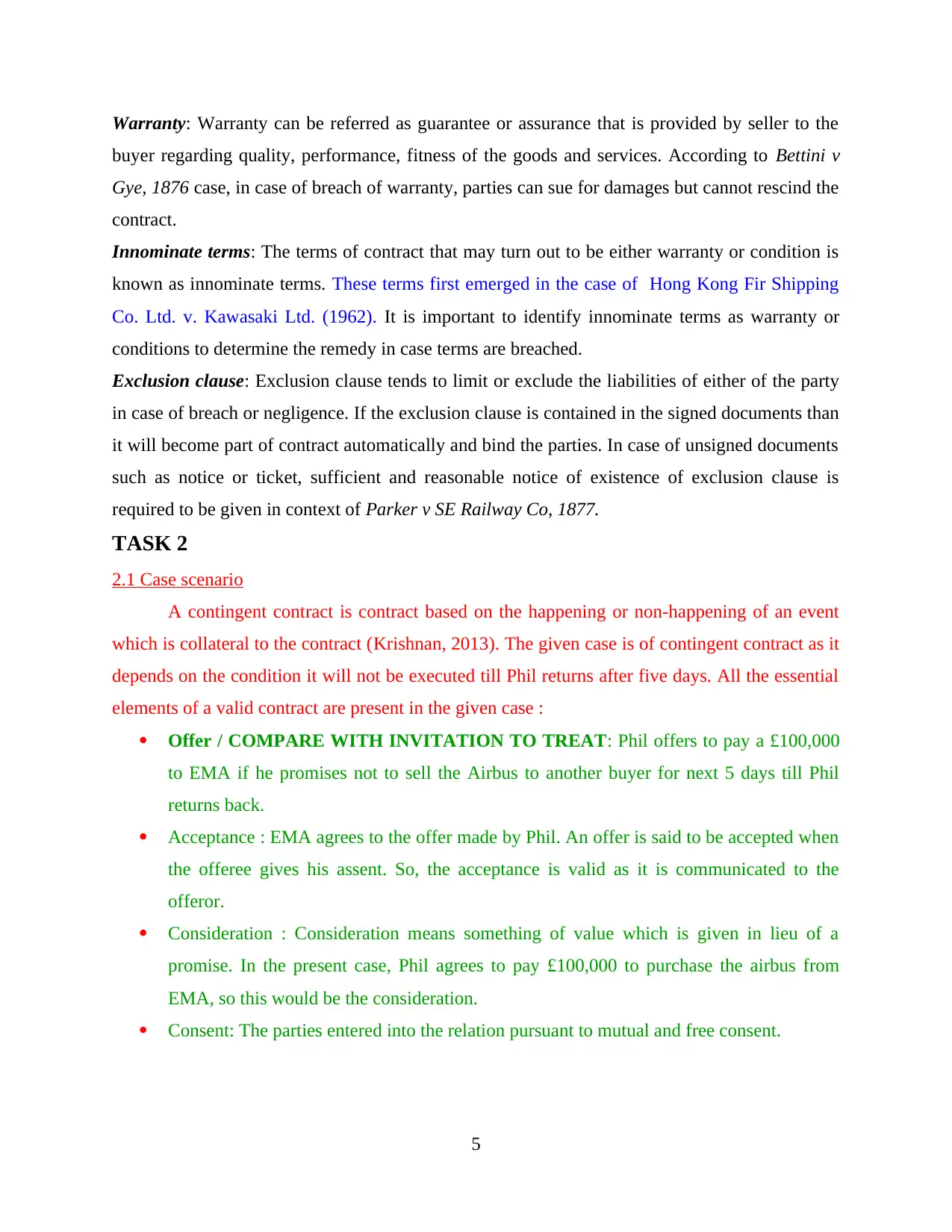
Warranty: Warranty can be referred as guarantee or assurance that is provided by seller to the
buyer regarding quality, performance, fitness of the goods and services. According to Bettini v
Gye, 1876 case, in case of breach of warranty, parties can sue for damages but cannot rescind the
contract.
Innominate terms: The terms of contract that may turn out to be either warranty or condition is
known as innominate terms. These terms first emerged in the case of Hong Kong Fir Shipping
Co. Ltd. v. Kawasaki Ltd. (1962). It is important to identify innominate terms as warranty or
conditions to determine the remedy in case terms are breached.
Exclusion clause: Exclusion clause tends to limit or exclude the liabilities of either of the party
in case of breach or negligence. If the exclusion clause is contained in the signed documents than
it will become part of contract automatically and bind the parties. In case of unsigned documents
such as notice or ticket, sufficient and reasonable notice of existence of exclusion clause is
required to be given in context of Parker v SE Railway Co, 1877.
TASK 2
2.1 Case scenario
A contingent contract is contract based on the happening or non-happening of an event
which is collateral to the contract (Krishnan, 2013). The given case is of contingent contract as it
depends on the condition it will not be executed till Phil returns after five days. All the essential
elements of a valid contract are present in the given case :
Offer / COMPARE WITH INVITATION TO TREAT: Phil offers to pay a £100,000
to EMA if he promises not to sell the Airbus to another buyer for next 5 days till Phil
returns back.
Acceptance : EMA agrees to the offer made by Phil. An offer is said to be accepted when
the offeree gives his assent. So, the acceptance is valid as it is communicated to the
offeror.
Consideration : Consideration means something of value which is given in lieu of a
promise. In the present case, Phil agrees to pay £100,000 to purchase the airbus from
EMA, so this would be the consideration.
Consent: The parties entered into the relation pursuant to mutual and free consent.
5
buyer regarding quality, performance, fitness of the goods and services. According to Bettini v
Gye, 1876 case, in case of breach of warranty, parties can sue for damages but cannot rescind the
contract.
Innominate terms: The terms of contract that may turn out to be either warranty or condition is
known as innominate terms. These terms first emerged in the case of Hong Kong Fir Shipping
Co. Ltd. v. Kawasaki Ltd. (1962). It is important to identify innominate terms as warranty or
conditions to determine the remedy in case terms are breached.
Exclusion clause: Exclusion clause tends to limit or exclude the liabilities of either of the party
in case of breach or negligence. If the exclusion clause is contained in the signed documents than
it will become part of contract automatically and bind the parties. In case of unsigned documents
such as notice or ticket, sufficient and reasonable notice of existence of exclusion clause is
required to be given in context of Parker v SE Railway Co, 1877.
TASK 2
2.1 Case scenario
A contingent contract is contract based on the happening or non-happening of an event
which is collateral to the contract (Krishnan, 2013). The given case is of contingent contract as it
depends on the condition it will not be executed till Phil returns after five days. All the essential
elements of a valid contract are present in the given case :
Offer / COMPARE WITH INVITATION TO TREAT: Phil offers to pay a £100,000
to EMA if he promises not to sell the Airbus to another buyer for next 5 days till Phil
returns back.
Acceptance : EMA agrees to the offer made by Phil. An offer is said to be accepted when
the offeree gives his assent. So, the acceptance is valid as it is communicated to the
offeror.
Consideration : Consideration means something of value which is given in lieu of a
promise. In the present case, Phil agrees to pay £100,000 to purchase the airbus from
EMA, so this would be the consideration.
Consent: The parties entered into the relation pursuant to mutual and free consent.
5
Paraphrase This Document
Need a fresh take? Get an instant paraphrase of this document with our AI Paraphraser
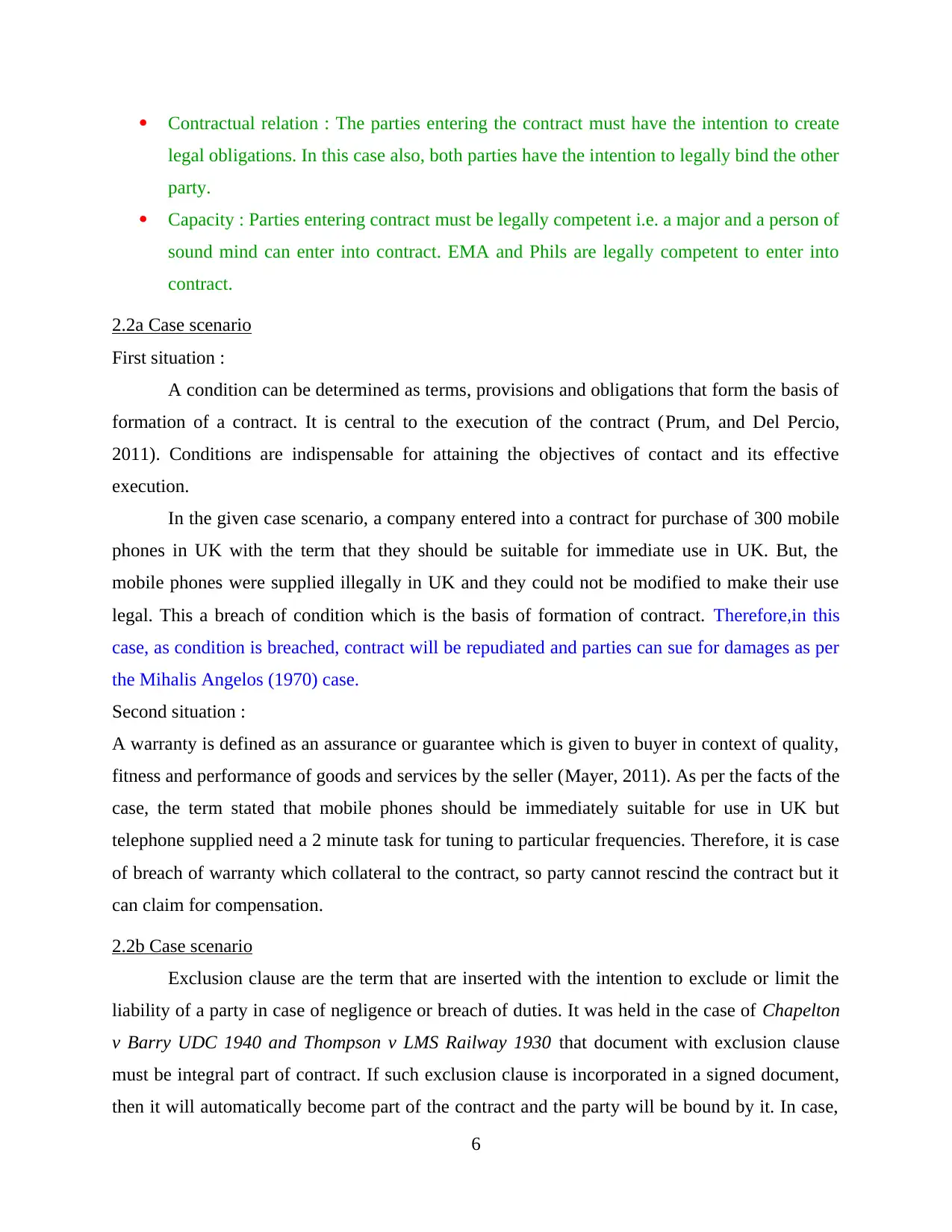
Contractual relation : The parties entering the contract must have the intention to create
legal obligations. In this case also, both parties have the intention to legally bind the other
party.
Capacity : Parties entering contract must be legally competent i.e. a major and a person of
sound mind can enter into contract. EMA and Phils are legally competent to enter into
contract.
2.2a Case scenario
First situation :
A condition can be determined as terms, provisions and obligations that form the basis of
formation of a contract. It is central to the execution of the contract (Prum, and Del Percio,
2011). Conditions are indispensable for attaining the objectives of contact and its effective
execution.
In the given case scenario, a company entered into a contract for purchase of 300 mobile
phones in UK with the term that they should be suitable for immediate use in UK. But, the
mobile phones were supplied illegally in UK and they could not be modified to make their use
legal. This a breach of condition which is the basis of formation of contract. Therefore,in this
case, as condition is breached, contract will be repudiated and parties can sue for damages as per
the Mihalis Angelos (1970) case.
Second situation :
A warranty is defined as an assurance or guarantee which is given to buyer in context of quality,
fitness and performance of goods and services by the seller (Mayer, 2011). As per the facts of the
case, the term stated that mobile phones should be immediately suitable for use in UK but
telephone supplied need a 2 minute task for tuning to particular frequencies. Therefore, it is case
of breach of warranty which collateral to the contract, so party cannot rescind the contract but it
can claim for compensation.
2.2b Case scenario
Exclusion clause are the term that are inserted with the intention to exclude or limit the
liability of a party in case of negligence or breach of duties. It was held in the case of Chapelton
v Barry UDC 1940 and Thompson v LMS Railway 1930 that document with exclusion clause
must be integral part of contract. If such exclusion clause is incorporated in a signed document,
then it will automatically become part of the contract and the party will be bound by it. In case,
6
legal obligations. In this case also, both parties have the intention to legally bind the other
party.
Capacity : Parties entering contract must be legally competent i.e. a major and a person of
sound mind can enter into contract. EMA and Phils are legally competent to enter into
contract.
2.2a Case scenario
First situation :
A condition can be determined as terms, provisions and obligations that form the basis of
formation of a contract. It is central to the execution of the contract (Prum, and Del Percio,
2011). Conditions are indispensable for attaining the objectives of contact and its effective
execution.
In the given case scenario, a company entered into a contract for purchase of 300 mobile
phones in UK with the term that they should be suitable for immediate use in UK. But, the
mobile phones were supplied illegally in UK and they could not be modified to make their use
legal. This a breach of condition which is the basis of formation of contract. Therefore,in this
case, as condition is breached, contract will be repudiated and parties can sue for damages as per
the Mihalis Angelos (1970) case.
Second situation :
A warranty is defined as an assurance or guarantee which is given to buyer in context of quality,
fitness and performance of goods and services by the seller (Mayer, 2011). As per the facts of the
case, the term stated that mobile phones should be immediately suitable for use in UK but
telephone supplied need a 2 minute task for tuning to particular frequencies. Therefore, it is case
of breach of warranty which collateral to the contract, so party cannot rescind the contract but it
can claim for compensation.
2.2b Case scenario
Exclusion clause are the term that are inserted with the intention to exclude or limit the
liability of a party in case of negligence or breach of duties. It was held in the case of Chapelton
v Barry UDC 1940 and Thompson v LMS Railway 1930 that document with exclusion clause
must be integral part of contract. If such exclusion clause is incorporated in a signed document,
then it will automatically become part of the contract and the party will be bound by it. In case,
6

such clause are inserted in an unsigned document like tickets or notice, then, they would be
considered only if sufficient and reasonable notice of its presence has been given.
In the given case scenario, Cathy has been servicing her car at Brakes Ltd. from last few
years. From last three ocassions, she has been required to sign a contractual document stating
that the company would not be liable for any consequential loss or injury as a result of any work
carried out by company even due to negligence(De Wardt, 2014). After collecting car from
service, Cathy was driving back to home but on the way she lost control and got hit with a tree.
The accident occurred as the mechanic failed to reconnect the car’s steering mechanism
properly.
Brakes Ltd. would not be liable even though accident occurred due to negligence of
mechanic as when a document containing exclusion clause is used over a period of time, then, it
is not necessary for the company to give notice of it again. Therefore, exclusion clause was
incorporated into her contract with Brakes Ltd.
2.3 Case scenario
The term inserted in a contract which seeks to limit or exclude the liabilities of one party
at the time of breach or negligence. The party may rely on such a clause -
a) if it is incorporated into the contract
b) it extends to loss in question due to matter of interpretation
c) it is valid as per Unfair Contract Terms Act 1977 i.e. under common law, duty to take
reasonable and due care in normal course of business. Moreover, as per statutory rule, a
person cannot exclude or limit his liability for death or personal injury caused due to
negligence.
(d) the Unfair Terms in Consumer Contracts Regulations 1999.
When an exclusion clause is inserted into a signed document, it is automatically become part of
contract and party will be bound by its terms (Jakobsen, 2010). As per the case of L'Estrange v
Graucob, 1934, party would be bound by exclusion clause even if is has not read the document.
An exclusion clause can also be incorporated into an unsigned document such as notice
or ticket after providing sufficient and reasonable notice of its existence.
It was held in the case of McCutcheon v MacBrayne, 1964 that when there are previous
consistent course of dealings on the same terms between the parties, then, it is not necessary to
provide sufficient notice regarding insertion of exclusion clause.
7
considered only if sufficient and reasonable notice of its presence has been given.
In the given case scenario, Cathy has been servicing her car at Brakes Ltd. from last few
years. From last three ocassions, she has been required to sign a contractual document stating
that the company would not be liable for any consequential loss or injury as a result of any work
carried out by company even due to negligence(De Wardt, 2014). After collecting car from
service, Cathy was driving back to home but on the way she lost control and got hit with a tree.
The accident occurred as the mechanic failed to reconnect the car’s steering mechanism
properly.
Brakes Ltd. would not be liable even though accident occurred due to negligence of
mechanic as when a document containing exclusion clause is used over a period of time, then, it
is not necessary for the company to give notice of it again. Therefore, exclusion clause was
incorporated into her contract with Brakes Ltd.
2.3 Case scenario
The term inserted in a contract which seeks to limit or exclude the liabilities of one party
at the time of breach or negligence. The party may rely on such a clause -
a) if it is incorporated into the contract
b) it extends to loss in question due to matter of interpretation
c) it is valid as per Unfair Contract Terms Act 1977 i.e. under common law, duty to take
reasonable and due care in normal course of business. Moreover, as per statutory rule, a
person cannot exclude or limit his liability for death or personal injury caused due to
negligence.
(d) the Unfair Terms in Consumer Contracts Regulations 1999.
When an exclusion clause is inserted into a signed document, it is automatically become part of
contract and party will be bound by its terms (Jakobsen, 2010). As per the case of L'Estrange v
Graucob, 1934, party would be bound by exclusion clause even if is has not read the document.
An exclusion clause can also be incorporated into an unsigned document such as notice
or ticket after providing sufficient and reasonable notice of its existence.
It was held in the case of McCutcheon v MacBrayne, 1964 that when there are previous
consistent course of dealings on the same terms between the parties, then, it is not necessary to
provide sufficient notice regarding insertion of exclusion clause.
7
⊘ This is a preview!⊘
Do you want full access?
Subscribe today to unlock all pages.

Trusted by 1+ million students worldwide
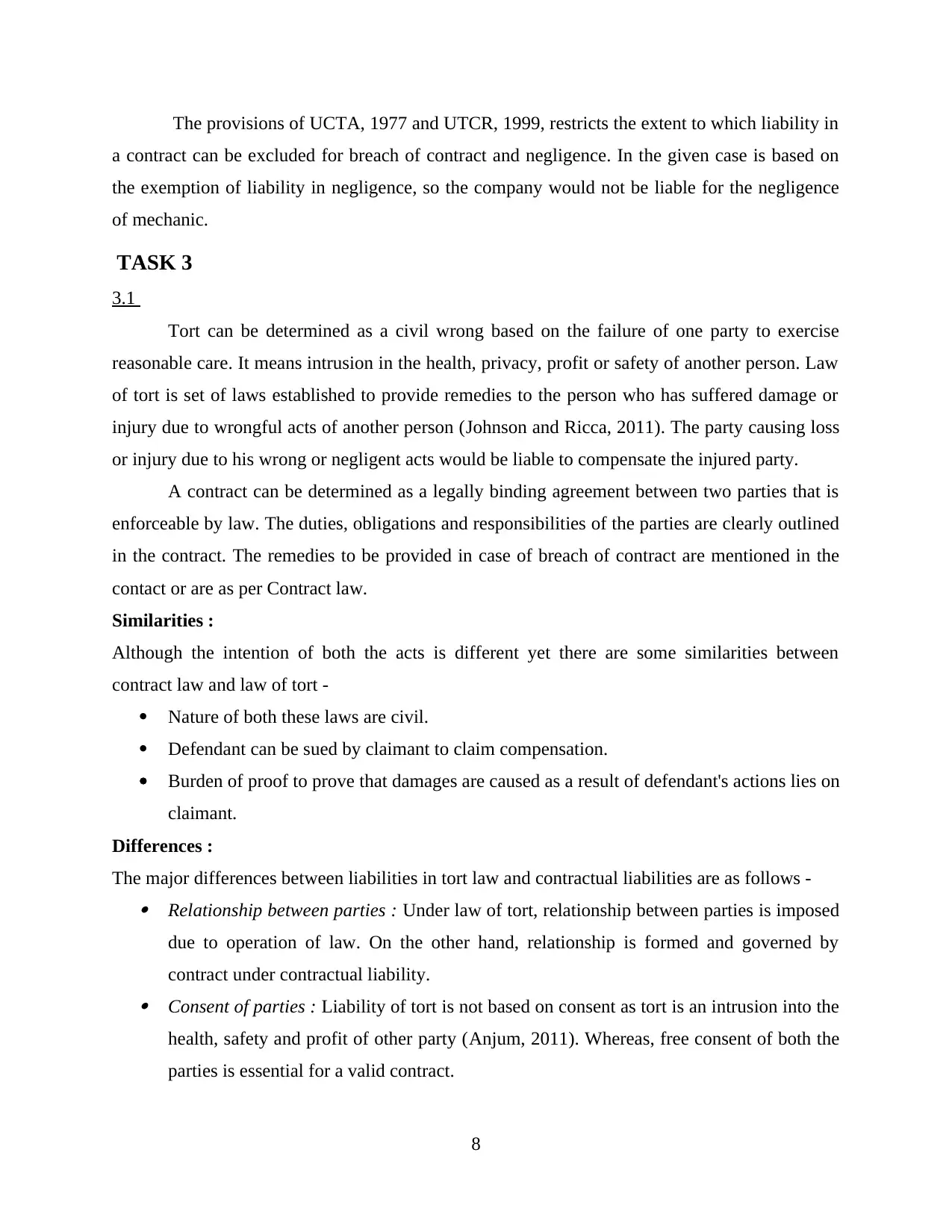
The provisions of UCTA, 1977 and UTCR, 1999, restricts the extent to which liability in
a contract can be excluded for breach of contract and negligence. In the given case is based on
the exemption of liability in negligence, so the company would not be liable for the negligence
of mechanic.
TASK 3
3.1
Tort can be determined as a civil wrong based on the failure of one party to exercise
reasonable care. It means intrusion in the health, privacy, profit or safety of another person. Law
of tort is set of laws established to provide remedies to the person who has suffered damage or
injury due to wrongful acts of another person (Johnson and Ricca, 2011). The party causing loss
or injury due to his wrong or negligent acts would be liable to compensate the injured party.
A contract can be determined as a legally binding agreement between two parties that is
enforceable by law. The duties, obligations and responsibilities of the parties are clearly outlined
in the contract. The remedies to be provided in case of breach of contract are mentioned in the
contact or are as per Contract law.
Similarities :
Although the intention of both the acts is different yet there are some similarities between
contract law and law of tort -
Nature of both these laws are civil.
Defendant can be sued by claimant to claim compensation.
Burden of proof to prove that damages are caused as a result of defendant's actions lies on
claimant.
Differences :
The major differences between liabilities in tort law and contractual liabilities are as follows - Relationship between parties : Under law of tort, relationship between parties is imposed
due to operation of law. On the other hand, relationship is formed and governed by
contract under contractual liability. Consent of parties : Liability of tort is not based on consent as tort is an intrusion into the
health, safety and profit of other party (Anjum, 2011). Whereas, free consent of both the
parties is essential for a valid contract.
8
a contract can be excluded for breach of contract and negligence. In the given case is based on
the exemption of liability in negligence, so the company would not be liable for the negligence
of mechanic.
TASK 3
3.1
Tort can be determined as a civil wrong based on the failure of one party to exercise
reasonable care. It means intrusion in the health, privacy, profit or safety of another person. Law
of tort is set of laws established to provide remedies to the person who has suffered damage or
injury due to wrongful acts of another person (Johnson and Ricca, 2011). The party causing loss
or injury due to his wrong or negligent acts would be liable to compensate the injured party.
A contract can be determined as a legally binding agreement between two parties that is
enforceable by law. The duties, obligations and responsibilities of the parties are clearly outlined
in the contract. The remedies to be provided in case of breach of contract are mentioned in the
contact or are as per Contract law.
Similarities :
Although the intention of both the acts is different yet there are some similarities between
contract law and law of tort -
Nature of both these laws are civil.
Defendant can be sued by claimant to claim compensation.
Burden of proof to prove that damages are caused as a result of defendant's actions lies on
claimant.
Differences :
The major differences between liabilities in tort law and contractual liabilities are as follows - Relationship between parties : Under law of tort, relationship between parties is imposed
due to operation of law. On the other hand, relationship is formed and governed by
contract under contractual liability. Consent of parties : Liability of tort is not based on consent as tort is an intrusion into the
health, safety and profit of other party (Anjum, 2011). Whereas, free consent of both the
parties is essential for a valid contract.
8
Paraphrase This Document
Need a fresh take? Get an instant paraphrase of this document with our AI Paraphraser
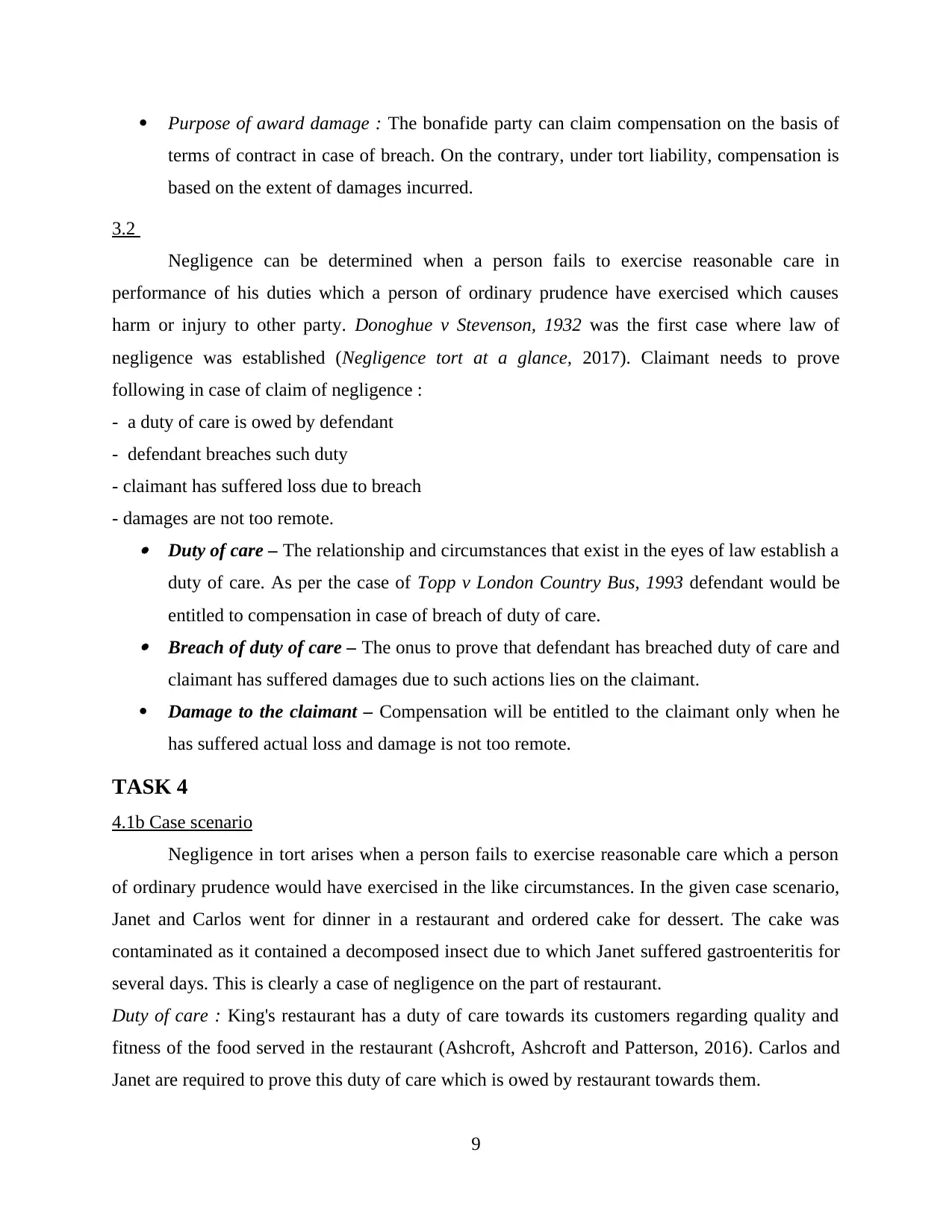
Purpose of award damage : The bonafide party can claim compensation on the basis of
terms of contract in case of breach. On the contrary, under tort liability, compensation is
based on the extent of damages incurred.
3.2
Negligence can be determined when a person fails to exercise reasonable care in
performance of his duties which a person of ordinary prudence have exercised which causes
harm or injury to other party. Donoghue v Stevenson, 1932 was the first case where law of
negligence was established (Negligence tort at a glance, 2017). Claimant needs to prove
following in case of claim of negligence :
- a duty of care is owed by defendant
- defendant breaches such duty
- claimant has suffered loss due to breach
- damages are not too remote. Duty of care – The relationship and circumstances that exist in the eyes of law establish a
duty of care. As per the case of Topp v London Country Bus, 1993 defendant would be
entitled to compensation in case of breach of duty of care. Breach of duty of care – The onus to prove that defendant has breached duty of care and
claimant has suffered damages due to such actions lies on the claimant.
Damage to the claimant – Compensation will be entitled to the claimant only when he
has suffered actual loss and damage is not too remote.
TASK 4
4.1b Case scenario
Negligence in tort arises when a person fails to exercise reasonable care which a person
of ordinary prudence would have exercised in the like circumstances. In the given case scenario,
Janet and Carlos went for dinner in a restaurant and ordered cake for dessert. The cake was
contaminated as it contained a decomposed insect due to which Janet suffered gastroenteritis for
several days. This is clearly a case of negligence on the part of restaurant.
Duty of care : King's restaurant has a duty of care towards its customers regarding quality and
fitness of the food served in the restaurant (Ashcroft, Ashcroft and Patterson, 2016). Carlos and
Janet are required to prove this duty of care which is owed by restaurant towards them.
9
terms of contract in case of breach. On the contrary, under tort liability, compensation is
based on the extent of damages incurred.
3.2
Negligence can be determined when a person fails to exercise reasonable care in
performance of his duties which a person of ordinary prudence have exercised which causes
harm or injury to other party. Donoghue v Stevenson, 1932 was the first case where law of
negligence was established (Negligence tort at a glance, 2017). Claimant needs to prove
following in case of claim of negligence :
- a duty of care is owed by defendant
- defendant breaches such duty
- claimant has suffered loss due to breach
- damages are not too remote. Duty of care – The relationship and circumstances that exist in the eyes of law establish a
duty of care. As per the case of Topp v London Country Bus, 1993 defendant would be
entitled to compensation in case of breach of duty of care. Breach of duty of care – The onus to prove that defendant has breached duty of care and
claimant has suffered damages due to such actions lies on the claimant.
Damage to the claimant – Compensation will be entitled to the claimant only when he
has suffered actual loss and damage is not too remote.
TASK 4
4.1b Case scenario
Negligence in tort arises when a person fails to exercise reasonable care which a person
of ordinary prudence would have exercised in the like circumstances. In the given case scenario,
Janet and Carlos went for dinner in a restaurant and ordered cake for dessert. The cake was
contaminated as it contained a decomposed insect due to which Janet suffered gastroenteritis for
several days. This is clearly a case of negligence on the part of restaurant.
Duty of care : King's restaurant has a duty of care towards its customers regarding quality and
fitness of the food served in the restaurant (Ashcroft, Ashcroft and Patterson, 2016). Carlos and
Janet are required to prove this duty of care which is owed by restaurant towards them.
9
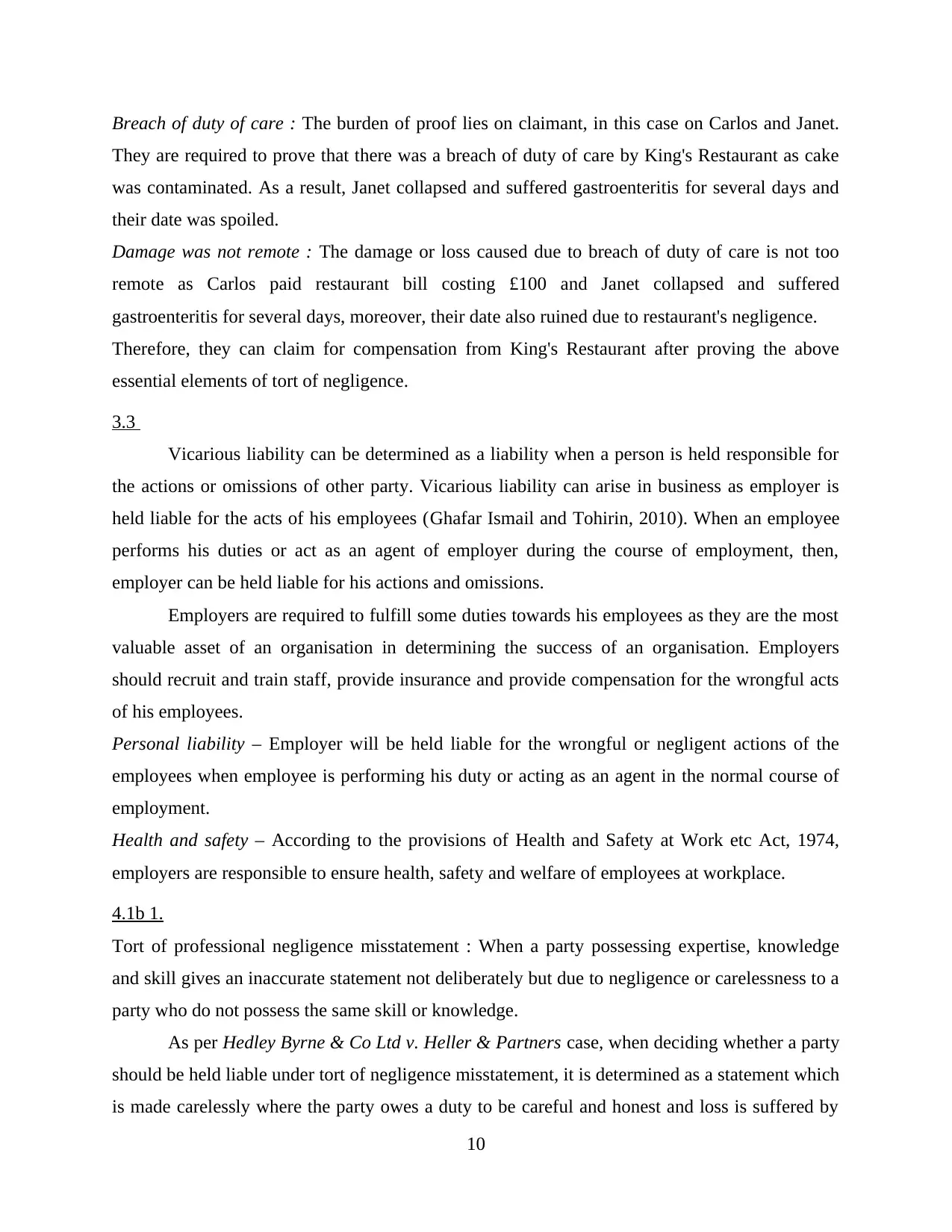
Breach of duty of care : The burden of proof lies on claimant, in this case on Carlos and Janet.
They are required to prove that there was a breach of duty of care by King's Restaurant as cake
was contaminated. As a result, Janet collapsed and suffered gastroenteritis for several days and
their date was spoiled.
Damage was not remote : The damage or loss caused due to breach of duty of care is not too
remote as Carlos paid restaurant bill costing £100 and Janet collapsed and suffered
gastroenteritis for several days, moreover, their date also ruined due to restaurant's negligence.
Therefore, they can claim for compensation from King's Restaurant after proving the above
essential elements of tort of negligence.
3.3
Vicarious liability can be determined as a liability when a person is held responsible for
the actions or omissions of other party. Vicarious liability can arise in business as employer is
held liable for the acts of his employees (Ghafar Ismail and Tohirin, 2010). When an employee
performs his duties or act as an agent of employer during the course of employment, then,
employer can be held liable for his actions and omissions.
Employers are required to fulfill some duties towards his employees as they are the most
valuable asset of an organisation in determining the success of an organisation. Employers
should recruit and train staff, provide insurance and provide compensation for the wrongful acts
of his employees.
Personal liability – Employer will be held liable for the wrongful or negligent actions of the
employees when employee is performing his duty or acting as an agent in the normal course of
employment.
Health and safety – According to the provisions of Health and Safety at Work etc Act, 1974,
employers are responsible to ensure health, safety and welfare of employees at workplace.
4.1b 1.
Tort of professional negligence misstatement : When a party possessing expertise, knowledge
and skill gives an inaccurate statement not deliberately but due to negligence or carelessness to a
party who do not possess the same skill or knowledge.
As per Hedley Byrne & Co Ltd v. Heller & Partners case, when deciding whether a party
should be held liable under tort of negligence misstatement, it is determined as a statement which
is made carelessly where the party owes a duty to be careful and honest and loss is suffered by
10
They are required to prove that there was a breach of duty of care by King's Restaurant as cake
was contaminated. As a result, Janet collapsed and suffered gastroenteritis for several days and
their date was spoiled.
Damage was not remote : The damage or loss caused due to breach of duty of care is not too
remote as Carlos paid restaurant bill costing £100 and Janet collapsed and suffered
gastroenteritis for several days, moreover, their date also ruined due to restaurant's negligence.
Therefore, they can claim for compensation from King's Restaurant after proving the above
essential elements of tort of negligence.
3.3
Vicarious liability can be determined as a liability when a person is held responsible for
the actions or omissions of other party. Vicarious liability can arise in business as employer is
held liable for the acts of his employees (Ghafar Ismail and Tohirin, 2010). When an employee
performs his duties or act as an agent of employer during the course of employment, then,
employer can be held liable for his actions and omissions.
Employers are required to fulfill some duties towards his employees as they are the most
valuable asset of an organisation in determining the success of an organisation. Employers
should recruit and train staff, provide insurance and provide compensation for the wrongful acts
of his employees.
Personal liability – Employer will be held liable for the wrongful or negligent actions of the
employees when employee is performing his duty or acting as an agent in the normal course of
employment.
Health and safety – According to the provisions of Health and Safety at Work etc Act, 1974,
employers are responsible to ensure health, safety and welfare of employees at workplace.
4.1b 1.
Tort of professional negligence misstatement : When a party possessing expertise, knowledge
and skill gives an inaccurate statement not deliberately but due to negligence or carelessness to a
party who do not possess the same skill or knowledge.
As per Hedley Byrne & Co Ltd v. Heller & Partners case, when deciding whether a party
should be held liable under tort of negligence misstatement, it is determined as a statement which
is made carelessly where the party owes a duty to be careful and honest and loss is suffered by
10
⊘ This is a preview!⊘
Do you want full access?
Subscribe today to unlock all pages.

Trusted by 1+ million students worldwide
1 out of 16
Related Documents
Your All-in-One AI-Powered Toolkit for Academic Success.
+13062052269
info@desklib.com
Available 24*7 on WhatsApp / Email
![[object Object]](/_next/static/media/star-bottom.7253800d.svg)
Unlock your academic potential
Copyright © 2020–2025 A2Z Services. All Rights Reserved. Developed and managed by ZUCOL.





